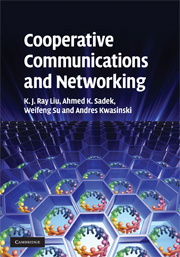Book contents
- Frontmatter
- Contents
- Preface
- Part I Background and MIMO systems
- Part II Cooperative communications
- Part III Cooperative networking
- 11 Cognitive multiple access via cooperation
- 12 Content-aware cooperative multiple access
- 13 Distributed cooperative routing
- 14 Source–channel coding with cooperation
- 15 Asymptotic performance of distortion exponents
- 16 Coverage expansion with cooperation
- 17 Broadband cooperative communications
- 18 Network lifetime maximization via cooperation
- References
- Index
14 - Source–channel coding with cooperation
from Part III - Cooperative networking
Published online by Cambridge University Press: 06 July 2010
- Frontmatter
- Contents
- Preface
- Part I Background and MIMO systems
- Part II Cooperative communications
- Part III Cooperative networking
- 11 Cognitive multiple access via cooperation
- 12 Content-aware cooperative multiple access
- 13 Distributed cooperative routing
- 14 Source–channel coding with cooperation
- 15 Asymptotic performance of distortion exponents
- 16 Coverage expansion with cooperation
- 17 Broadband cooperative communications
- 18 Network lifetime maximization via cooperation
- References
- Index
Summary
The design of wireless devices and networks present unique design challenges due to the combined effects of physical constraints, such as bandwidth and power, and communication errors introduced through channel fading and noise. The limited bandwidth has to be addressed through a compression operation that removes redundant information from the source. Unfortunately, the removal of redundancy makes the transmitted data not only more important but also more sensitive to channel errors. Therefore, it is necessary to complement the source compression operation with the application of an error control code to do channel coding. The goal of the channel coding operation is to add redundancy back to the source coded data that has been designed to efficiently detect and correct errors introduced in the channel. In this chapter we will study the use of cooperation to transmit multimedia traffic (such as voice or video conferencing). This involves studying the performance of schemes with strict delay constraint where user cooperation is combined with source and channel coding.
Although the source and channel codecs complement each other, historically their design had been approached independently of each other. The basic assumptions in this design method are that the source encoder will present to the channel encoder a bit stream where all source redundancy have been removed and that the channel decoder will be able to present to the source decoder a bit stream where all channel errors have been corrected.
- Type
- Chapter
- Information
- Cooperative Communications and Networking , pp. 478 - 513Publisher: Cambridge University PressPrint publication year: 2008



